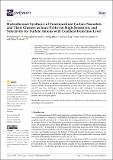| dc.contributor.author | Yang, Po-Chih | |
| dc.contributor.author | Panda, Pradeep Kumar | |
| dc.contributor.author | Li, Cheng-Han | |
| dc.contributor.author | Ting, Yu-Xuan | |
| dc.contributor.author | Ashraf Gandomi, Yasser | |
| dc.contributor.author | Hsieh, Chien-Te | |
| dc.date.accessioned | 2023-06-27T16:44:55Z | |
| dc.date.available | 2023-06-27T16:44:55Z | |
| dc.date.issued | 2023-06-12 | |
| dc.identifier.uri | https://hdl.handle.net/1721.1/150958 | |
| dc.description.abstract | Nitrogen-doped carbon nanodots (CNDs) were synthesized and utilized as sensing probes to detect different anions and metallic ions within aqueous solutions. The pristine CNDs were developed through a one-pot hydrothermal synthesis. <i>o</i>-Phenylenediamine was used as the precursor. A similar hydrothermal synthesis technique in the presence of polyethylene glycol (PEG) was adopted to form the PEG-coated CND clusters (CND-100k). Through photoluminescence (PL) quenching, both CND and PEG-coated CND suspensions display ultra-high sensitivity and selectivity towards HSO<sub>4</sub><sup>−</sup> anions (Stern–Volmer quenching constant (<i>K</i><sub>SV</sub>) value: 0.021 ppm<sup>−1</sup> for CND and 0.062 ppm<sup>−1</sup> for CND-100k) with an ultra-low detection limit (LOD value: 0.57 ppm for the CND and 0.19 ppm for CND-100k) in the liquid phase. The quenching mechanism of N-doped CNDs towards HSO<sub>4</sub><sup>−</sup> ions involves forming the bidentate as well as the monodentate hydrogen bonding with the sulfate anionic moieties. The detection mechanism of metallic ions analyzed through the Stern–Volmer formulation reveals that the CND suspension is well suited for the detection of Fe<sup>3+</sup> (<i>K</i><sub>SV</sub> value: 0.043 ppm<sup>−1</sup>) and Fe<sup>2+</sup> (<i>K</i><sub>SV</sub> value: 0.0191 ppm<sup>−1</sup>) ions, whereas Hg<sup>2+</sup> (<i>K</i><sub>SV</sub> value: 0.078 ppm<sup>−1</sup>) sensing can be precisely performed by the PEG-coated CND clusters. Accordingly, the CND suspensions developed in this work can be employed as high-performance PL probes for detecting various anions and metallic ions in the liquid phase. | en_US |
| dc.publisher | Multidisciplinary Digital Publishing Institute | en_US |
| dc.relation.isversionof | http://dx.doi.org/10.3390/polym15122655 | en_US |
| dc.rights | Creative Commons Attribution | en_US |
| dc.rights.uri | http://creativecommons.org/licenses/by/4.0/ | en_US |
| dc.source | Multidisciplinary Digital Publishing Institute | en_US |
| dc.title | Hydrothermal Synthesis of Functionalized Carbon Nanodots and Their Clusters as Ionic Probe for High Sensitivity and Selectivity for Sulfate Anions with Excellent Detection Level | en_US |
| dc.type | Article | en_US |
| dc.identifier.citation | Polymers 15 (12): 2655 (2023) | en_US |
| dc.contributor.department | Massachusetts Institute of Technology. Department of Chemical Engineering | |
| dc.identifier.mitlicense | PUBLISHER_CC | |
| dc.eprint.version | Final published version | en_US |
| dc.type.uri | http://purl.org/eprint/type/JournalArticle | en_US |
| eprint.status | http://purl.org/eprint/status/PeerReviewed | en_US |
| dc.date.updated | 2023-06-27T13:21:50Z | |
| dspace.date.submission | 2023-06-27T13:21:50Z | |
| mit.license | PUBLISHER_CC | |
| mit.metadata.status | Authority Work and Publication Information Needed | en_US |
